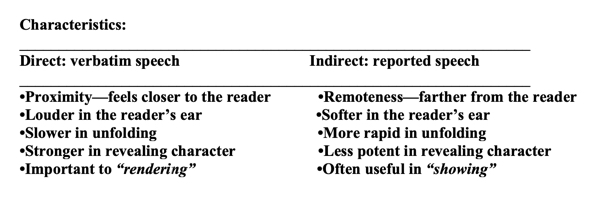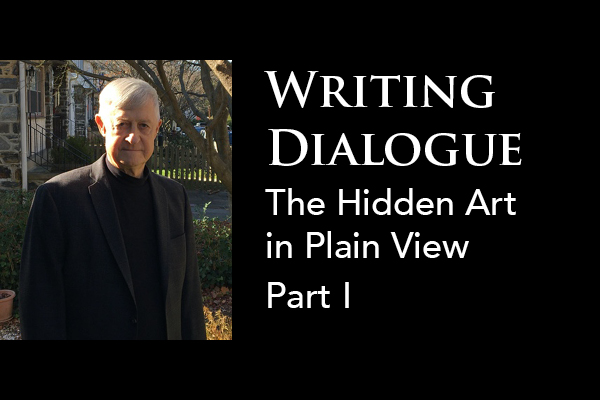The Hidden Art in Plain View
By WTP Writer Richard Wertime
Woven Tale Press writer Richard Wertime reflects
on the craft of fiction in an ongoing series of craft notes
“’… Well, what’s to be said?’ the Worm murmured to the Tortoise.”
(Source unattributed)
Few readers, indeed, will have even the faintest awareness of the wide range of strategies a writer might deploy in enacting a “conversation.”
… And the more skillfully a writer puts such strategies to work, the less discernible those strategies are destined to become: the dialogue will appear to be ordinary talk going on among people. That the reader accepts as lifelike what the characters are saying is the measure of the writer’s skill in exercising guile.
The achievement of this quality, this “naturalness” of effect, is among the forms of transparency we aspire to as writers. —And a very important one, for (here’s a rule),
The masterly control of writing dialogue in fiction is one of the key earmarks of a writer’s high craft.*
In this note, we’ll consider—begin to explore—the minefield of devices (caveat lector!) open to the writer for managing dialogue in a story, all while lulling the reader into a state of unawareness that a very high degree of manipulation is being practiced in the presentation of simple-seeming “speech.” Dialogue, well crafted, manifests sprezzatura as few other feats of literary technique will.
(*We accept that some writers will break the usual “rules” and still manage the “speech” among their characters very skillfully. Tillie Olsen’s story “Hey Sailor, What Ship?” and Hubert Selby, Jr.’s Last Exit to Brooklyn offer excellent examples.)
“Direct” vs. “indirect” discourse—live, verbatim speech as distinct from “reported” speech:
Many writers, not just readers, remain unaware of the panoply of options available to them, not only for writing dialogue, but also for controlling all the elements of their craft. It’s important (as I’ve said elsewhere) to possess a vocabulary for talking to ourselves about ourselves regarding technical matters, especially when we sense that we’re having a problem, but haven’t the language for seeking a solution.
So—what options do we have for causing dialogue to move quickly? For slowing it down? For making a “moment” in conversation appear consequential, or, inversely, incidental? For raising the volume of a speech act, or making it quiet and recessive, remote from the listener—suitable, say, for merely imparting information? In which form does dialogue most readily reveal the character of the speaker? These are questions key to our considerations here. Some definitions first:
-
- Direct discourse: “live” dialogue, direct verbatim (word-for-word) speech; what the person “actually says,” in American orthography usually framed (though not always) in quotation marks, e.g., “I really didn’t want to,” she said.
- Indirect discourse: “reported” speech, the reader being told that something was being said, the information in question being conveyed to the reader by the narrator of the story, no quotation marks framing the statement, e.g., She told him that she really didn’t want to.
About the first, direct discourse, we’ll observe that, by convention, it has two key properties: (a) it unfolds in real time—occupies as much time, exactly, as it takes to “say” whatever; and (b) is taken to be wholly reliable as an account of what the person has actually said, no “filtering,” editing, or distortion involved. The reader, that is to say, has direct, trustworthy access to what the character has uttered, no one “interposing” to alter the statement. For this reason, said Aristotle, drama—live theater, where the characters on stage get to speak for themselves—is the most truly “political” of literary art forms, since the audience hears what the actors are saying unimpeded.
And about direct discourse, let’s add that, as we’re reading, it proceeds more slowly and more laboriously than indirect discourse does, and seems to have been spoken within close proximity—we have to be “within earshot” to have heard it at all.*
Regarding indirect discourse, we’ll note that it tends (a) to be “quieter” to the reader’s ear, (b) seems to be more remote from the here-and-now of our presence, and (c) moves more quickly as a form of story-telling than direct discourse does. Finally (d), it proves less effective than live dialogue in “manifesting” the essential character of the speaker.
For convenience and clarity, let’s put these different attributes in a chart:

Knowing how these two might be deployed in writing dialogue will enable you to control tone and pacing in new ways—but we have another distinction that we must add here first to enrich our terminology, and our awareness of our options.
(*This relative slowness may be attributable, at least in part, to its unfolding in “real time,” though it may also be the case that readers tend to “re-enact” it—read it subverbally, “aloud” to themselves.)
~
“Synoptic” indirect vs. “detailed” indirect discourse: the range of options available:
When speech is “reported” rather than rendered “live,” it can serve (a) as a terse summary of a great deal that’s been said, or (b) it can spell out in detail what someone is saying, which will cause it to swerve quite close to “live speech” in its effect on the reader, even while continuing to sound somewhat “remote” and move rapidly enough. So, shown graphically, here’s the range of possibilities:

Take the following passage:
They discussed their holiday. It had been lovely hadn’t it?—even if Joey (oh, so careless sometimes!) had taken that spill, his dirt bike all mangled. Not the worst that could have happened, they’d been in agreement. And all the other kids had done so well!
In this example, They discussed their holiday” is synoptic indirect, whereas the remainder of the passage, by comparison, is in detailed indirect—all of it, however, remaining within the parameters of indirect discourse.
And here’s a neat trick for having the best of both worlds, for enjoying both the immediacy and feeling of proximity in hearing “live” speech, and, at the same time, the relative rapidity of indirect speech! Watch how “tagging” just a line of dialogue onto the end of that passage will give all of it the feel of having been “spoken” close up!
They discussed their holiday. It had been lovely hadn’t it?—even if Joey (oh, so careless sometimes!) had taken that spill, his dirt bike all mangled. Not the worst that could have happened, they’d been in agreement. And all the other kids had done so well! “So, . . . about next summer, then—what do you think?”
Skillful writers know how to “infect” their passages of indirect discourse, even lengthy ones, with the feeling of proximity and live, hands-on immediacy… go watch Bobbie Ann Mason do it consummately in her great story, “Shiloh”!
~
The next craft note will consider how direct and indirect discourse can be blended— “modulated,” you might say, to produce a swifter pace and greater smoothness in dialogue. We’ll also look at certain narrative “shortcuts” that can contribute to an overall compression of effect.
Read Richard Wertime’s short fiction, “Soccer,” in WTP, and find his other reflections on craft here.

